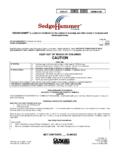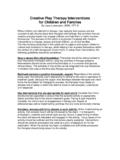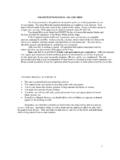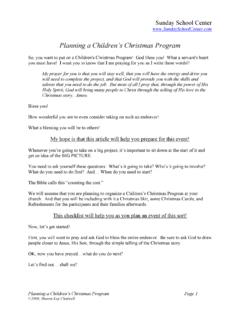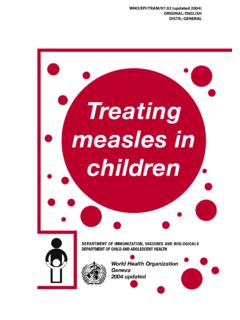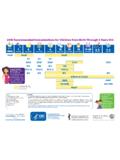Transcription of FOR CHILDREN OF MEDICINES - World Health …
1 PROMOTING safety OF MEDICINESFOR CHILDRENISBN 978-92-4-156343-7 PROMOTING safety OF MEDICINES FOR CHILDRENP harmacovigilance and medicine safety issues in CHILDREN arerelevant to everyone who has an interest in and cares about thehealth of CHILDREN . The purpose of this guideline is I)to present acase for the importance of the improving safety monitoring ofmedicines for CHILDREN , II)to describe possible ways of achieving itand III)to provide an outline for national pharmacovigilanceprogrammes to make them more sensitive and open to adversereactions to MEDICINES in 10/07/07 17:10 Page 1 WHO LIBRARY CATALOGUING-IN-PUBLICATION DATA:Promoting safety of MEDICINES for preparations - administration and monitoring. drug reactionreporting systems. Health 978-92-4-156343-7(NLM classification: WS 366) World Health ORGANIZATION 2007 All rights reserved.
2 Publications of the World Health Organizationcan be obtained from WHO Press, World Health Organization,20 Avenue Appia, 1211 Geneva 27, Switzerland (tel.: +41 22 791 3264;fax: +41 22 791 4857; e-mail: Requests forpermission to reproduce or translate WHO publications whetherfor sale or for noncommercial distribution should be addressed to WHO Press, at the above address (fax: +41 22 791 4806; The designations employed and the presentation of the material inthis publication do not imply the expression of any opinionwhatsoever on the part of the World Health Organizationconcerning the legal status of any country, territory, city or area orof its authorities, or concerning the delimitation of its frontiers orboundaries. Dotted lines on maps represent approximate borderlines for which there may not yet be full mention of specific companies or of certain manufacturers products does not imply that they are endorsed or recommendedby the World Health Organization in preference to others of asimilar nature that are not mentioned.))
3 Errors and omissionsexcepted, the names of proprietary products are distinguished byinitial capital reasonable precautions have been taken by the World HealthOrganization to verify the information contained in thispublication. However, the published material is being distributedwithout warranty of any kind, either expressed or implied. Theresponsibility for the interpretation and use of the material lies withthe reader. In no event shall the World Health Organization beliable for damages arising from its in 10/07/07 17:10 Page 10/07/07 17:11 Page 623 PROMOTING safety OF MEDICINESFOR 10/07/07 17:11 Page 34 AcknowledgementsThis publication was developed following a recommendation of the WHOA dvisory Committee for the safety of Medicinal Products. The draft manuscripthas been widely circulated and discussed at several consultations withinternational experts in regulatory affairs and in paediatrics.
4 WHO isparticularly grateful to Nilima A. Kshirsagar, India, Hansj rgen Seyberth,Germany, and the Karolinska, Sweden for their initial input to this thanks are also due to the following persons for their valued expertisein evaluating this publication. Niamh Arthur, Ireland, J rgen Beckmann, Germany, Ulf Bergman, Sweden, David Coulter, New Zealand, Gerald Dal Pan, USA, I. Ralph Edwards, Sweden, Murilo Freitas Dias, Brazil, Kenneth Hartigan-Go, Philippines, Li Dakui, China, Sten Olsson, Sweden, June Raine, UK, Anders Rane, Sweden, Gunilla Sj l n-Forsberg, Sweden, Rachida Soulaymani-Bencheikh, editing: Mary R. Couper, WHO and Susan KaplanArt direction: Guillaume Desbiolles, Calleo PortageAssistance in production of document: Caroline Scudamore, WHO WHO expresses its sincere appreciation to the Government of Sweden forproviding financial support to finance the drafting of the 10/07/07 17:11 Page 45 Promoting safety of MEDICINES for children1 Introduction.
5 P. 72 Current situation.. p. with medicine treatment in CHILDREN and adolescents around the World .. p. of present status of the useof MEDICINES in CHILDREN (environmental aspects).. p. risk factors that predispose CHILDREN to develop an adverse reaction to a medicine (medical aspects).. p. between paediatric populations and adults.. p. need for additional, independent studies on the development of paediatric MEDICINES .. p. legal and regulatory framework.. p. of the lack of studies of MEDICINES development in CHILDREN and authorization of paediatric MEDICINES .. p. 193 The essential role of safety monitoring in the life-cycle of a medicine .. p. assessment of medicine safety .. p. monitoring of medicine safety for MEDICINES already on the market including those used off-label .. p. considerations in CHILDREN .. p. 234 Medication errors.
6 P. risk of medication errors in CHILDREN .. p. of medication errors .. p. 265 Primary responsibility of stakeholders.. p. 296 Guidance: measures to be taken.. p. of awareness among stakeholders.. p. , approaches and infrastructure for an effective system for medicine safety monitoring at the national level.. p. of methods and structural changes for effective monitoring of medicine safety at the national level.. p. measurement and audit.. p. 377 Measures to be taken by WHO.. p. 39 References.. p. 41 Annex IPharmacovigilance methods.. p. 43 References.. p. 50 Annex 2 Recent information on adverse reactions to marketed MEDICINES in CHILDREN .. p. 51 References.. p. 571234567 Annex 1 Annex 10/07/07 17:11 Page 10/07/07 17:11 Page 61234567 Annex 1 Annex 21. INTRODUCTIONM onitoring the safety of medicine use in CHILDREN is of paramount importancesince, during the clinical development of MEDICINES , only limited data on thisaspect are generated through clinical trials.
7 Use of MEDICINES outside thespecifications described in the licence ( in terms of formulation, indications,contraindications or age) constitutes off-label and off-licence use and these area major area of guidelines are intended to improve awareness of medicine safety issuesamong everyone who has an interest in the safety of MEDICINES in CHILDREN andto provide guidance on effective systems for monitoring medicine safety in thepaediatric populations. The document will be of interest to all Health -careprofessionals, medicine regulatory authorities, pharmacovigilance centres,academia, the pharmaceutical industry and for monitoring medicine safety are described in Annex 1 - Pharmacovigilancemethods and some examples of recent information on adverse reactionsto marketed MEDICINES are discussed in Annex is the science and activities relating to the detection,assessment, understanding and prevention of adverse effects or any otherpossible medicine -related problems (1).
8 For the purposes of this document,an adverse reaction to a medicine (ADR) includes not only reactions occurringduring normal use of MEDICINES , but also reactions due to errors in medicineadministration, non-adherence, overdose, off-label use, drug abuse andadverse effects due to the use of traditional and complementary does not address the paediatric use of vaccines. Separate WHO guidelineson safety monitoring of vaccine use in CHILDREN will be developed in the 10/07/07 17:11 Page 10/07/07 17:11 Page 81234567 Annex 1 Annex 22. CURRENT Problems with medicine treatment in CHILDREN andadolescents around the worldThe following problems occur with the use of MEDICINES in the treatment ofchildren and adolescents. Often, MEDICINES used are off-label and unlicenced. Over-the-counter, traditional and herbal MEDICINES are readily available,but their use is generally not evidence-based and is often inappropriate.
9 Counterfeit and substandard MEDICINES are widespread. Abuse by teenagers occurs with non-medical prescription of legalmedicines and illegal drugs. New and innovative MEDICINES are available with a paediatric indication, butwith no evidence of long-term benefit and risk, the biological agentsused as disease modifying antirheumatic MEDICINES , such as , in resource-poor countries the following may apply: No treatment may be available, particularly during times of war and civil strife. MEDICINES may be available through illegal street vendors. MEDICINES are used in public Health driven programmes for thetreatment of endemic infectious diseases such as HIV/AIDS, malaria,tuberculosis and for parasitic diseases. In many low-income countries, much of the medicine supply is by-passing theofficial Health care system. Consumers with limited buying power often acquiremedicines from acquaintances, relatives and unregistered vendors who havelittle or no Health -care training.
10 In these countries, prescription MEDICINES mayoften be acquired without a prescription from markets and chemist s resulting self-medication, unsupervised by any Health professional, is alsohaving a major effect on CHILDREN . This situation is associated with high risksfor adverse consequences because of the risk of poor-quality MEDICINES beingtaken and the absence of information on how to use MEDICINES in if serious adverse reactions occur as a result of self-medication withproducts acquired from street markets, they are often not reported to anyhealth practitioner, since seeing a Health professional is often not feasible or isconsidered too expensive. Civil society and non-governmental organizationsneed to be engaged in soliciting information from local communities aboutchild Health and possible medicine -related problems affecting about the actual extent of medicine -related problems in CHILDREN inthese settings can only be collected through systematic active surveillance.










